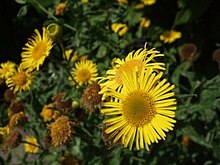Pulicaria dysenterica
| Pulicaria dysenterica | |
|---|---|

| |
| Scientific classification | |
| Kingdom: | Plantae |
| Clade: | Tracheophytes |
| Clade: | Angiosperms |
| Clade: | Eudicots |
| Clade: | Asterids |
| Order: | Asterales |
| Family: | Asteraceae |
| Genus: | Pulicaria |
| Species: | P. dysenterica
|
| Binomial name | |
| Pulicaria dysenterica | |
Pulicaria dysenterica, the common fleabane,[1] or, in North America, meadow false fleabane,[2] is a species of fleabane in the daisy family. It is native to Europe and western Asia where it grows in a variety of habitats ranging from semi-arid Mediterranean woodlands to wetter situations.[3] Pulicaria dysenterica is perennial and can form dense clusters of plants, spreading by its roots. It flowers at its maximum height of about 60 centimetres (2.0 ft).[4] Leaves are alternately arranged and clasp the stem, which itself contains a salty-astringent liquid. The yellow inflorescences are typically composed of a prominent centre of 40–100 disc florets surrounded by 20–30 narrow, pistillate ray florets. When setting seed the flower heads reflex.[5]
Fleabane's common name comes from its former use as an incense to drive away insects.[5] Other past uses include treatments for dysentery and unspecified ocular maladies.[3]
References
- ^ "BSBI List 2007". Botanical Society of Britain and Ireland. Archived from the original (xls) on 2015-01-25. Retrieved 2014-10-17.
- ^ USDA, NRCS (n.d.). "Pulicaria dysenterica". The PLANTS Database (plants.usda.gov). Greensboro, North Carolina: National Plant Data Team. Retrieved 16 October 2015.
- ^ a b http://chestofbooks.com/flora-plants/flowers/British-Wild-Flowers-1/Fleabane-Pulicaria-Dysenterica-Gray.html
- ^ http://www.pfaf.org/database/plants.php?Pulicaria+dysenterica
- ^ a b http://www.efloras.org/florataxon.aspx?flora_id=1&taxon_id=127631
External links
- Pulicaria dysenterica at Plants for a Future
- Common fleabane at Naturespot
- Pulicaria dysenterica at Emorgate seeds
External links
![]() Media related to Pulicaria dysenterica at Wikimedia Commons
Media related to Pulicaria dysenterica at Wikimedia Commons
